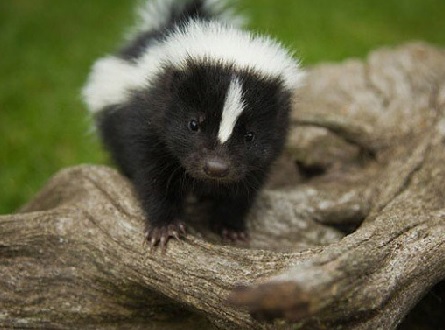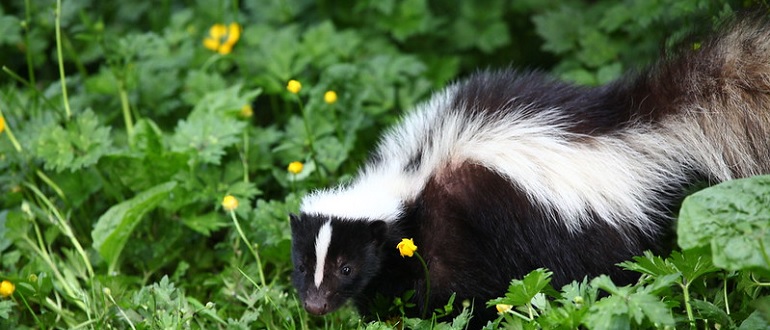Beyond the Stink
GET TO KNOW Striped skunks
Skunks get a bad rap. Too often, homeowners get one whiff of skunk spray and declare a neighborhood “skunk problem”.
FUN FACT: Skunks are one of the few mammals that are immune to both snake and bee/wasp venom and are strong predators for both. In areas with lots of snakes, a resident skunk or two provides a pretty good snake patrol.
But if one looks beyond the “stink factor”, it is evident that these handsome little fuzzies are important citizens of the watershed. Striped skunks provide free insect, rodent, and snake control services that are actually beneficial to farmers and gardeners. Indeed, rather than get upset with the neighborhood skunk for a few holes in the lawn, just consider it free grub control and thank the little guy for his services. He will do less overall lawn damage than widespread grubs will.
Seriously though, the best grub management is a strong, healthy root system in the lawn. Per the MSU Extension, deep grass roots are best achieved by healthy lawn care practices of: mowing high (3.5″), using minimal fertilizer, and watering deeply – but only during dry periods. See our website at Healthy Lawn Care for more information on healthy lawn care.
Skunks are quiet, shy, solitary creatures that amble about their business throughout the night and hide away during the day. For skunks, the world is a dangerous and scary place. There are owls, dogs, cars, and angry homeowners. Striped skunks are fairly small (about the size of house cats). They have short little legs and can’t run very well. Research indicates they have poor eyesight and hearing. Technically, their striking black and white coloring is intended to serve as a warning of their fearsome spraying power. However, the noxious spay itself, is really their one – and only – line of defense.
Keep in mind that skunks do not want to spray – or even encounter – people and pets. Given the opportunity, they prefer to waddle away rather than confront. Also, when cornered, they provide plenty of warning before letting loose with the spray. So, if you encounter a scared little skunk and he stomps his feet and arches his back, consider yourself warned. Just back off, and give him some space. He will most likely amble off.
LIFESTYLE AND HABITAT
Striped skunks are the only species of skunk native to southeast Michigan. Their natural range extends across southern Canada, throughout the lower 48 US states and into northern Mexico. While a scrubby, semi-open area (near a stream for water) is their most preferred habitat, these guys are very adaptable; and urban sprawl has brought them into our parks and gardens.
Skunks are solitary by nature. In warm weather, they meander about their individual territories through the night and take daytime shelter in temporary found spaces in hollow trees, abandoned dens, and wood piles. In cold climates, skunks must retreat to a protective den to doze away the winter months in a semi-dormant state. While normally solitary, striped skunks will sometimes huddle up together (to conserve body heat) in a cozy winter den. During this time, they rely primarily on fat storage for survival and may lose as much as 50% of their body weight. However, since they do not fully hibernate, these adorable little critters are occasionally seen poking about in the snow in the hope of finding a mid-winter snack.
Male skunks are springtime Casanovas. They wander about hoping to romance every lady skunk they meet. The ladies, though, prefer to keep their distance and tolerate only one fellow each spring. After mating, the partners go their separate ways; and after a two-month pregnancy, the female bears and raises her little family (usually 4 – 5 kits) on her own. Baby skunks are born blind, hairless, and helpless.
At about three weeks of age, the babies can venture out of the den and follow their mama to learn how to hunt and forage for themselves. Skunks are true omnivores and eat a mixture of tiny rodents, lizards, insects, eggs, and plants. At six months of age, young male skunks strike out on their own,

but young females often stay with their mother through fall and winter and only leave when mating season comes around the next spring.
Under ideal conditions, striped skunks can live 7 – 10 years. However, nature rarely offers such conditions, and a great many skunks do not survive their first year of life. They are, unfortunately, susceptible to many diseases (including rabies); and large birds of prey appear to be immune to the skunk’s musky spray. Large owls are the primary natural predator of skunks. And while most predatory mammals learn to avoid skunks, canines never seem to get the message. Both dogs, and their wild coyote cousins, pose serious threats to skunks.
TAKE ACTION
In the highly urbanized Rouge River watershed, skunks are most threatened by road accidents and dogs. Their long-term survival depends on preservation of natural riparian corridors along the river and its tributaries.
Remember, skunks are shy. They don’t want to spray you. In fact, their supply of special “skunk stink” is quite limited. If they use it all up – say on your family dog – they are defenseless for many days while their body regenerates the musk oils in their glands. So, give skunks some space, and help preserve their place in the watershed by helping Friends of the Rouge protect their natural habitat. See our website at Volunteer to see how you can help today.
MAIN PHOTO CREDIT: Striped skunk: Photo by GO-TO-VAN CC-BY-2.0 – image cropped
